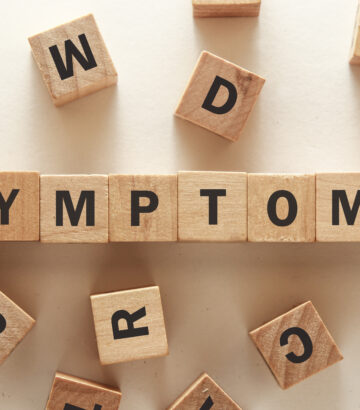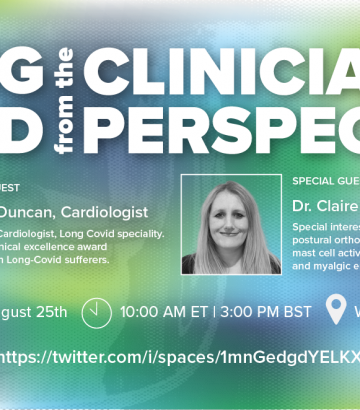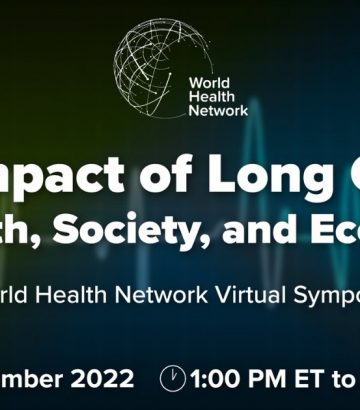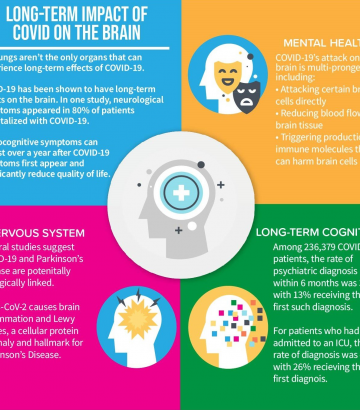Implications of Long COVID for Society
It has become clear that long COVID affects a considerable proportion of COVID survivors. While people who have ongoing symptoms of long COVID may adjust their expectations of their own health and abilities, a significant proportion find day-to-day activities are strongly impacted, and many are disabled at work and in home activities.
Several recent, large studies report around one in three who have been infected experience long COVID symptoms, including people with mild or asymptomatic acute infections [1]. Given that an estimated 60% of the US population [2] have been infected, and similarly high proportions in other countries [3], a large number of people around the world are experiencing some degree of long COVID symptoms.
The severity of an individual’s symptoms and its impact on their work and home lives vary. Studies that focus on more severe long COVID cases still find a substantial percentage are impacted. By early July 2022, data from the Office of National Statistics reported that long COVID symptoms adversely affected the day-to-day activities of 1.3 million people in the UK. Of these, 369,000 (21%) reported that their abilities had been “limited a lot” [4]. All aspects of a person’s life may be affected, and many are so profoundly disabled that they can no longer return to work or school, care for their families, or perform basic self-care.
Some people are at increased risk for long COVID or its effects because of where they live or work, or because they don’t have access to healthcare. Health inequities may put people from racial or ethnic minority groups and with prior conditions or disabilities at greater risk for developing post-COVID conditions or being unable to support themselves or obtain care for their conditions once they have them.
Unfortunately, it is also clear that neither vaccination nor infection generates lasting immunity so that reinfections are occurring much more rapidly and having a more severe impact than many expected [5]. With new, increasingly transmissible and immunity evading variants, the number of COVID survivors and the number of people who have been infected multiple times is increasing. Vaccines give some, but far from full protection against long COVID [6], and although some reports show a smaller percentage of people get long COVID from Omicron than earlier variants [7], the sheer number of people infected and reinfected means a lot more people will experience long COVID going forward. Over time, some long COVID patients recover, but a large study reported that in those still experiencing symptoms two months after the acute illness, 85% were still not well after one year [4]. One study finds that half of those hospitalized still have at least one symptom two years later [8].
The large array of long-term bodily, psychiatric, and neurologic symptoms [9,10] are of a kind that impact both the individual’s and society’s functioning. In the following sections on family, healthcare, workplace, and the economy we discuss the implications of long COVID for society.
Family Systems

In addition to the consequences from the staggering COVID death toll, many families are disrupted by the consequences of the long-term disabilities and burden of long COVID. Although long COVID can affect anyone, studies imply that it disproportionately affects women, and those already socially and economically at risk, groups that often are unable to work remotely during the pandemic [11]. With long-term illness comes also the need for carers for those ill. This will often fall on family members; most countries have not had the resources to give families support, socially, emotionally, or financially, amid an ongoing pandemic.
Healthcare Systems

The pandemic has had dire effects on many health care workers after their lengthy efforts on the front line. Many were infected in the early days and many are now suffering from symptoms of long COVID and organ damage from the acute infection. In addition, many have been absent with acute COVID infections, especially during surges [12], adding to the burden of those still at work — in a workplace with massively increased workload. Consequently, burnout [13] has become a serious issue.
All of this has taken its toll on health care workers. Many countries have seen substantial reductions in the number of available health care workers, and more may be seen in the future. In the US, a study found that 40% of the nurses and 24% of the physicians had an intention to leave their practice within 2 years. In addition to long COVID disability, burnout, fear of exposure and its consequences, COVID-19-related anxiety/depression, and workload were predictors of intent to leave [14]. Projections made by the Association of American Medical Colleges (AAMC) have found that within a dozen years, the US will face a shortage of physicians by between 37,800 and 124,000 doctors [15]. Similar gaps are to be expected in other countries where COVID has been allowed to spread. This will have even greater consequences given the massive backlogs of unaddressed care in many countries after the first two years of pandemic, including implications for non-COVID patients as they may not be able to access timely, quality, and safe healthcare resources.
Into this scenario, the new and complex disease of long COVID makes its entry, with more than 200 identified symptoms [10]. Many symptoms related to long COVID are of a kind that requires advanced, non-routine diagnostics that until now most often have been handled by specialist centers and clinicians working with rare, systemic diseases; clinicians who often have had long wait lists even before the pandemic.
Thus, at this time, we are seeing an increasing need coupled with diminishing resources. The demand for highly specialized medical care from several medical specialties is increasing dramatically, at a point in time where the supply is lower.
The discrepancy between the need for health care and the services that are offered and available is adding to the burden for those struggling with long-term symptoms. Many of the symptoms from long COVID are debilitating, but invisible from the outside. Similar to patients with ME/Chronic Fatigue Syndrome, many long COVID sufferers have had an experience of being ignored or minimized when seeking help. Long-haulers also face barriers to prove their illness to access disability benefits [16]. We hope that as science progresses, more knowledge is disseminated, and the effects of the symptoms from COVID are recognized, this will change.
Workplaces

Long COVID is also having an impact on the workforce [17,18] outside the healthcare system due to disabilities and sick leave. This is affecting a wide range of occupations and business sectors. During the pandemic, teachers have been especially at risk for COVID infections. Now, the prevalence of long COVID is among the greatest in those working in childcare, teaching and education, in addition to those working in social care and health care [19]. Both long COVID and burnout are consequences that can lead to a reduction in the number of available teachers going forward.
“Brain fog”, reduced memory, and impaired concentration are among symptoms that frequently persist after COVID infections. This may lead to loss of function in ways that are especially harmful for many activities in modern workplaces, including abilities to make plans and synthesize information. Of those still able to work, many will have an increased need for flexibility and adaptability at work for long periods to come, and some will need training and re-certifications to be able to stay in the workforce. According to a study from Mount Sinai Hospital in New York, those affected suffer from memory loss, inability to form new memories, and difficulty with speaking [20]. Dr. David Putrino, the Director of Rehabilitation Innovation at Mount Sinai, describes long COVID as “a very debilitating condition with serious cognitive conditions” [21].
This again may lead to loss of key employees or loss of trust in their capabilities. Many businesses and organizations face uncertainty as to who of their key employees and other workers will be available in the future. For knowledge-based organizations, this may severely impact production. For organizations such as the military, the loss in reliability of individual capability may lead to crucial strategic issues, if the affected are key personnel that are difficult to replace. In addition, the military may be impacted directly through a reduction in the number of individuals in the armed forces [22]. This may, consequently, affect the safety and security of nations.
Economy

In many countries, employers in different sectors are struggling to find workers, and long COVID plays an important role. The Brookings Institution has found that long COVID could account for 15% of unfilled jobs in the US [23], and in a recent survey, a quarter of UK employers cited long COVID as driving absences [24]. These effects may pose a threat to economic activity and its stability, adding to the otherwise uncertain economic climate. After work participation in the UK has fallen by 450,000 (1.3% of the labor force) due to a persistent rise in long-term sickness of around 320,000 people linked to the pandemic, the Bank of England now sees long COVID and the effects on public health and work participation as a very serious issue and notes that this problem cannot be addressed by economic interventions: “It is just not one that monetary policy is well designed to tackle” [25].
Long COVID impacts the economy in a wide range of ways. There are direct costs such as health care costs, medication costs, and social welfare costs to support the ill and disabled [26]. Whether these costs are borne by public or subsidized corporate insurance (as in the US), the drag they will produce on economic activity is substantial. But society will also see costs in the form of reduced productivity and tax revenue from those no longer working. Reduced spending from people who have seen a reduction in income means reduced consumption on a macro level, which in itself leads to reduced economic growth.
During the pandemic, the world has seen disruptions to supply chains, both on a local and global level. The pandemic has affected shipping, trucking, ports, and warehouses, and in some cases led to shortages of food and other goods. The many workers affected by long COVID have become a significant part of the impact on these sectors. With the war in Ukraine, the challenges in some sectors, including food supply, have increased in magnitude.
What lies ahead depends on measures taken to prevent infections, and the frequency and severity of long COVID symptoms over time. Recent findings that vaccines do not provide strong protection against long COVID undermine the hope of relief brought on by vaccinations. Especially noteworthy are the scientific findings that may predict an increased risk of developing neurodegenerative disorders such as Alzheimer’s dementia [27] or Parkinson’s disease [28] over years to come. It is also worth remembering that survivors of the SARS outbreak in 2003 often experienced debilitating and sometimes increasing symptom burden over many years, and the most serious long-term effects after polio were first visible decades after the acute infection.
Conclusion
Although much is still uncertain, it is evident that long COVID is and will be a problem of unprecedented magnitude. The societal and economic impact of long COVID may be one of modern society’s major challenges in the years to come. At present, the only way to be sure to avoid getting long COVID is to avoid being infected. Acting to reduce transmission on the local, national, and global level, is essential to protecting individuals and society from the adverse long-term effects of COVID. Improving the understanding of care and treatments is essential for those who already are suffering from long COVID.
References
- World Health Network: What is long COVID – scientific information. https://www.worldhealthnetwork.global/whatislongcovid
- Clarke et al: Seroprevalence of Infection-Induced SARS-CoV-2 Antibodies — United States, September 2021–February 2022. Center for Disease Control and Prevention, 2022. https://www.cdc.gov/mmwr/volumes/71/wr/mm7117e3.htm
- Our World In Data: Cumulative confirmed COVID-19 cases per million people. https://ourworldindata.org/coronavirus#explore-the-global-situation
- Office for National Statistics. Prevalence of ongoing symptoms following coronavirus (COVID-19) infection in the UK: 4 August 2022. https://www.ons.gov.uk/peoplepopulationandcommunity/healthandsocialcare/conditionsanddiseases/bulletins/prevalenceofongoingsymptomsfollowingcoronaviruscovid19infectionintheuk/4august2022
- Al-Aly et al: Outcomes of SARS-CoV-2 Reinfection. Pre-print, ResearchSquare, 2022. https://www.researchsquare.com/article/rs-1749502/v1
- H. Ledford, Do vaccines protect against long COVID? What the data say, Nature 2022, https://www.nature.com/articles/d41586-021-03495-2
- Antonelli M,et al, Risk of long COVID associated with delta versus omicron variants of SARS-CoV-2, Lancet 2022, https://doi.org/10.1016/S0140-6736(22)00941-2
- Tran et al: Course of post COVID-19 disease symptoms over time in the ComPaRe long COVID prospective e-cohort. Nature Communications, 2022. https://www.nature.com/articles/s41467-022-29513-z
- Huang et al: Health outcomes in people 2 years after surviving hospitalization with COVID-19: a longitudinal cohort study. Lancet Resp Med, 2022. https://www.thelancet.com/journals/lanres/article/PIIS2213-2600(22)00126-6/fulltext
- Davies et al: Characterizing long COVID in an international cohort: 7 months of symptoms and their impact. Lancet eClinicalMedicine, 2021. https://www.thelancet.com/journals/eclinm/article/PIIS2589-5370(21)00299-6/fulltext
- Taquet et al: 6-month neurological and psychiatric outcomes in 236 379 survivors of COVID-19: a retrospective cohort study using electronic health records. Lancet Psychiatry, 2021. https://www.thelancet.com/journals/lanpsy/article/PIIS2215-0366(21)00084-5/fulltext
- Subramanian et al: Symptoms and risk factors for long COVID in non-hospitalized adults. Nature Med, July 2022. https://www.nature.com/articles/s41591-022-01909-w
- Prasad et al: Prevalence and correlates of stress and burnout among U.S. healthcare workers during the COVID-19 pandemic: A national cross-sectional survey study. Lancet eClin Med, 2021. https://www.sciencedirect.com/science/article/pii/S2589537021001590
- Pollak, S.: Nearly 3,900 hospital staff absent from work during final week of January due to Covid. Irish Times, 2022. https://www.irishtimes.com/news/health/nearly-3-900-hospital-staff-absent-from-work-during-final-week-of-january-due-to-covid-1.4796260
- Sinsky et al: COVID-Related Stress and Work Intentions in a Sample of US Health Care Workers. Mayo Clinic Proceedings, 2021. https://www.mcpiqojournal.org/article/S2542-4548(21)00126-0/fulltext#%20
- Robeznieks, A.: What we’ve learned about COVID-19, burnout and the doctor shortage. American Medical Association, 2022. https://www.ama-assn.org/practice-management/sustainability/what-we-ve-learned-about-covid-19-burnout-and-doctor-shortage
- Hsu, A: Millions of Americans have long COVID. Many of them are no longer working, NPR, 2022. https://www.npr.org/2022/07/31/1114375163/long-covid-longhaulers-disability-labor-ada
- The Workforce Challenge of Long Covid, Fast Forward, 2022 https://www.bsr.org/en/emerging-issues/the-workforce-challenge-of-long-covid
- The Pandemic Pandora’s Box. Long COVID and Episodic Disability. Report, Realize Canada, 2021. https://www.realizecanada.org/wp-content/uploads/The-Pandemic-Pandoras-Box.pdf
- Becker et al: Assessment of Cognitive Function in Patients After COVID-19 Infection. JAMA Network Open, 2021. https://jamanetwork.com/journals/jamanetworkopen/fullarticle/2785388?resultClick=3
- DeCiccio, E.: Long Covid ‘is a very debilitating condition with serious cognitive conditions,’ says researcher behind new study. CNBC, Oct. 25., 2021. https://www.cnbc.com/2021/10/25/long-covid-is-a-very-debilitating-condition-with-serious-cognitive-conditions-says-researcher-behind-new-study.html
- Even as omicron infections trend down, long COVID remains a threat to the military. Bulletin of the Atomic Scientists, 2022. https://thebulletin.org/2022/02/even-as-omicron-infections-trend-down-long-covid-remains-a-threat-to-the-military
- Bach, K.: Is ‘long Covid’ worsening the labor shortage? Brookings Institution, 2022. https://www.brookings.edu/research/is-long-covid-worsening-the-labor-shortage/
- Quarter of UK employers cite long COVID as driving absences – survey. Reuters, Feb. 8., 2022. https://www.reuters.com/world/the-great-reboot/quarter-uk-employers-cite-long-covid-driving-absences-survey-2022-02-08/
- Treasury Committee, UK. Meeting, Monday 16. May 2022. https://parliamentlive.tv/Event/Index/eb8510a1-697a-4273-9a42-ba9f3072c338
- Health Expenditures (2018), https://www.cdc.gov/nchs/fastats/health-expenditures.htm
- Shen et al: SARS-CoV-2 invades cognitive centers of the brain and induces Alzheimer’s-like neuropathology. bioRxiv, 2022. https://www.biorxiv.org/content/10.1101/2022.01.31.478476v2
- Hamoy et al: Parkinson’s disease secondary to COVID-19: a systematic review. Research, Society and Development, 2021. https://rsdjournal.org/index.php/rsd/article/view/24397








